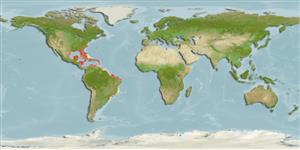Common names from other countries
Environment: milieu / climate zone / depth range / distribution range
экология
; пределы глубины 4 - 100 m (Ref. 108813). Tropical
Western Atlantic.
Length at first maturity / Size / Вес / Возраст
Maturity: Lm ? range ? - ? cm
Shape varies as globular, almost spherical, or erect egg-shaped; apex usually flattened or depressed. Common width is between 15 to 20 cm. Surface scarred with numerous round cup-like depressions, i.e., porocalices, concentrating in the apical depression. Radiated spicules, protruding tips make remaining surface bristly. External color: orange, yellow-orange, or brownish orange. May be brown due to presence of algae or cyanobacteria. Rich yellow internally. Consistency elastic but firm. Few oscules.
Life cycle and mating behavior
половая зрелость | размножение | нерест | икра | Fecundity | личинки
Members of the class Demospongiae are hermaphroditic. Life cycle: The zygote develops into parenchymella larva (free-swimming) before settling down on a substrate where it grows into a young sponge.
Основная ссылка
ссылки | координатор | соавторы
Zea, S., T.P. Henkel and J.R. Pawlik. 2009. (Ref. 81728)
Статус Красного Списка МСОП (Ref. 130435: Version 2024-1)
Статус СИТЕС (Ref. 108899)
Not Evaluated
Not Evaluated
Использование человеком
| FishSource |
инструменты
дополнительная информация
Возраст/РазмерыростЗависимость между длиной и массой телаЗависимость между длинамиморфологияличинкичисленность
ресурсы в Интернет
Estimates based on models
Preferred temperature
(Ref.
115969): 22.8 - 27.8, mean 25.7 (based on 340 cells).
Категория цены
Unknown.
